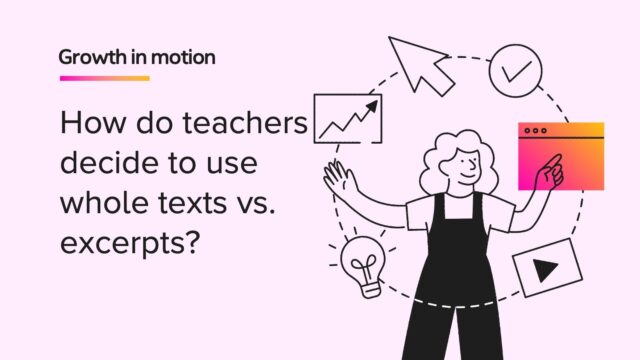
Digital writing programs can be an effective way to carve out time for writing lessons during the school day. An added bonus? They've been shown to increase engagement and improve skills when properly implemented by teachers. These platforms can also make it easier to encourage writing across the curriculum by scaffolding instruction for non-English Language Arts teachers.
Unfortunately, not all digital writing programs are created equally. With so many choices available, teachers may find themselves overwhelmed. The following questions are key points to consider when choosing a program. Please note, the issue of cost is not being addressed in this article. Whether you are examining free, ‘freemium,’ or purchase-required programs, the following questions should serve as a guide.

1. What resources are provided to aid in teaching?
Not all digital writing programs supply the same materials. Most provide writing prompts for assignments, but the better ones allow teachers to customize assignments to fit their needs. You should be able to add your own readings or media, edit the rubrics, and more. Ideally, digital writing programs should also offer guidelines for peer review as well as a dedicated space in the platform for writing feedback from peers and teachers. In addition to feedback, offering mentor texts that align with writing prompts can be a helpful feature. Bonus points for any digital writing program that includes grammar lessons to scaffold the editing process!
2. Are all the steps of the writing process included?
This one may seem obvious, but not all digital writing programs take students through the entire writing process, from brainstorming to publishing. A comprehensive program will cover prewriting (often referred to as brainstorming), drafting, reviewing, revising, editing, and, finally, publishing. This is important for a number of reasons. Often students will skip brainstorming and jump right into writing if they're not directed to plan first. Also, many of our struggling writers do not fully comprehend the need for revision and editing. A platform that guides students through each stage of the writing process can be a real game changer. Students should have access to each draft of their writing as well as the feedback they received during the process. When students are able to get feedback from teachers and peers, and multiple chances to submit revisions, they experience writing as a process—not a one and done endeavor.
3. What types of rubrics are available and are they customizable?
The best digital writing programs offer a variety of rubrics that allow for customization by the teacher. Rubric types may include the different options for scoring (4-, 5-, and 6-point). They might also focus on specific types of writing such as persuasive, expository, descriptive, and narrative, or focus on standards aligned to your state or specific assessment. Teachers should be able to edit the rubrics to precisely align with an assignment. Allowing teachers to upload their own rubrics also makes a program stand out from the pack. Furthermore, rubrics should be made available to students while they write and when participating in peer or self-review. This makes it easy for feedback to align with the standards and expectations of the assignment.

4. Does the program support best research practices?
One of the most difficult parts of teaching writing is incorporating best practices for research. Students today are so used to Googling a question or asking Siri and Alexa for homework help. They do not understand the difference between a quick search for an answer and in-depth research to support persuasive writing. They need to be taught how to recognize quality research sources and, more importantly, how to give proper credit. The best digital writing platforms offer citation assistance, which may be in the form of an automatic citation generator or access to examples of proper citation format for different types of sources. Citation examples should be made available in MLA as well as APA formats. Some digital platforms even offer links to scholarly research sources like online databases or Google Scholar. Whether or not the program partners with research options, information should be available about how to identify good research sources.
5. Does the program offer opportunities to write for an authentic audience?
Writing digitally makes it so much easier to address authentic audiences. When students compose in an online platform, it is an obvious next step to publish their work for a broader audience beyond the classroom. Truly great digital writing platforms have that publishing step built in. Publishing student work may look different depending on students' ages. Students who are 13 years and older* may wish to publish their work more globally, and some digital writing platforms have blogging capabilities already embedded in their program.
For younger students, it would be best to have their ‘published’ work only available to a select audience. Some platforms allow for a gallery of student work to be seen by fellow enrolled students only. If this isn’t included in the program, it is always possible to use online platforms like Weebly to publish student work in a secure setting. Educators know that having an authentic audience is important for student writing because it increases engagement. Knowing their work will be seen by their peers is a greater motivator compared to turning in an assignment that is for teachers' eyes only.
*Please note: many online platforms and school districts have age restrictions based on the sharing of student data. Typically, students who are at least 13 years old are approved for applications that collect data and publish student work. Best practice is always to secure parent permission whenever sharing student work beyond the ‘walled garden’ of a school-approved LMS.
The views expressed in this article are those of the author and do not necessarily represent those of HMH.
***
Get a free trial of Writable and see how it can support your ELA curriculum, district benchmarks, and state standards with more than 600 fully customizable writing assignments and rubrics for students in Grades 3–12.












